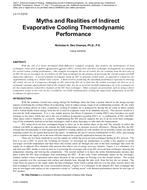Click here to purchase
With the aid of a newly developed finite-difference computer program, that predicts the performance of heat exchangers when used as Indirect Evaporative Coolers (IEC), various flow and heat exchanger arrangements are analyzed for overall system cooling performance. One example investigates the use of cooled, dry air resulting from the first pass of an IEC for use as scavenger air in a follow-on IEC heat exchanger for the purpose of increasing the overall system wet-bulb depression efficiency. A second example investigates using an IEC to generate cooled water, as opposed to cooled air, for supplemental cooling in a chilled water system. A third involves predicting the maximum performance expected by drawing off cooled, dry air as it progresses through an IEC and using this air to feed into the wetted scavenger air flow so as to eventually consume approximately half of the original inlet, dry air as lowered wet-bulb temperature air to be scavenger air for the evaporatively cooled flow channels of the IEC heat exchanger. Other concepts are presented, such as using a direct evaporative cooler to pre-cool air for a condenser coil while simultaneously cooling the sump-water temperature of an IEC to enhance its effectiveness.
Citation: ASHRAE Conference Papers, Las Vegas, NV
Product Details
- Published:
- 2011
- Number of Pages:
- 12
- File Size:
- 1 file , 2 MB
- Product Code(s):
- D-LV-11-C015
